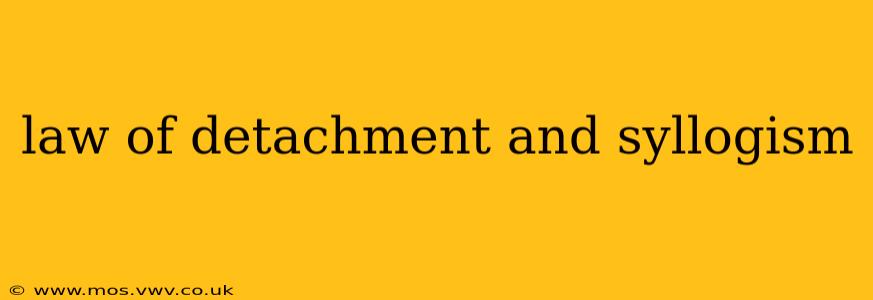The laws of detachment and syllogism are fundamental principles in logic, forming the bedrock of deductive reasoning. Understanding these concepts is crucial for critical thinking, problem-solving, and even everyday decision-making. This article will explore both, highlighting their differences and demonstrating their practical applications.
What is the Law of Detachment?
The Law of Detachment, also known as modus ponens, is a rule of inference that allows us to conclude a statement is true based on the truth of a conditional statement and its hypothesis. A conditional statement has the form "If P, then Q," where P is the hypothesis and Q is the conclusion. The Law of Detachment states:
- If P, then Q.
- P is true.
- Therefore, Q is true.
Example:
- If it is raining (P), then the ground is wet (Q).
- It is raining (P is true).
- Therefore, the ground is wet (Q is true).
The Law of Detachment is straightforward and intuitively appealing. If we know a conditional statement is true and its hypothesis is true, then we can confidently conclude the conclusion is also true.
What is a Syllogism?
A syllogism is a type of logical argument consisting of three parts: a major premise, a minor premise, and a conclusion. The major premise is a general statement, the minor premise relates a specific case to the general statement, and the conclusion follows logically from the two premises. There are many forms of syllogisms, but the most common is the categorical syllogism. This follows a structure like this:
- Major Premise: All A are B.
- Minor Premise: All C are A.
- Conclusion: Therefore, all C are B.
Example:
- Major Premise: All dogs (A) are mammals (B).
- Minor Premise: All golden retrievers (C) are dogs (A).
- Conclusion: Therefore, all golden retrievers (C) are mammals (B).
What are the Differences Between the Law of Detachment and Syllogism?
While both the Law of Detachment and syllogisms are forms of deductive reasoning, they differ in their structure and complexity:
-
Structure: The Law of Detachment involves a single conditional statement and its hypothesis, leading to a direct conclusion. A syllogism, on the other hand, involves two premises and a conclusion, often involving categorical statements (all, some, no).
-
Complexity: The Law of Detachment is a simpler form of deductive reasoning, while syllogisms can be more complex and involve multiple relationships between different categories.
-
Application: The Law of Detachment is useful in situations where we have a conditional statement and know the hypothesis is true. Syllogisms are useful for drawing conclusions based on general principles and specific instances.
How are the Law of Detachment and Syllogism Used in Everyday Life?
Both the Law of Detachment and syllogisms are constantly used, often unconsciously, in everyday decision-making and problem-solving:
-
Law of Detachment: "If I study hard (P), then I will pass the exam (Q). I studied hard (P). Therefore, I will pass the exam (Q)."
-
Syllogism: "All birds (A) have feathers (B). A robin (C) is a bird (A). Therefore, a robin (C) has feathers (B)."
Can the Law of Detachment be used within a Syllogism?
Yes, the Law of Detachment can be a component within a larger syllogistic argument. A complex argument might use the Law of Detachment to derive an intermediate conclusion, which then becomes a premise in a further syllogistic inference.
What are some examples of invalid syllogisms?
Invalid syllogisms arise when the conclusion doesn't logically follow from the premises. Here's an example of a common fallacy:
- Major Premise: All cats are mammals.
- Minor Premise: All dogs are mammals.
- Invalid Conclusion: Therefore, all cats are dogs. (This is incorrect; they share a category but are distinct.)
Understanding the structure and principles of valid syllogisms is crucial for avoiding these fallacies.
Conclusion
The Law of Detachment and syllogisms are powerful tools for clear thinking and logical reasoning. Mastering these concepts enables us to construct sound arguments, evaluate claims critically, and make more informed decisions in all aspects of life. While distinct in their structure, they both represent the fundamental principles of deductive logic.
